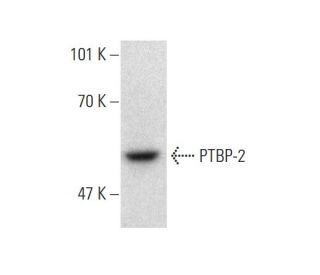


Y79 nuclear extract: sc-2126
- supplied in four vials, each containing 250 µg nuclear extract in 50 µl buffer
- provided in 20 mM HEPES (pH 7.9), 20% v/v glycerol, 0.1 M KCI, 0.2 mM EDTA, 0.5 mM PMSF and 0.5 mM DTT
- human nuclear extract; retinoblastoma cells
- suitable for use in Gel Shift and Western Blotting assays
- Extracts should be stored at -70°C and repeated freezing and thawing should be avoided.
- prepared by the method of Dignam et al., (1983) Nucleic Acids Res. 11: 1475
QUICK LINKS
SEE ALSO...
Y79 nuclear extract, derived from the Y79 retinoblastoma cell line, is extensively utilized in cancer biology research to explore cellular mechanisms pertinent to tumor progression and gene regulation in retinal cells. This extract is particularly valuable for studying the regulation of retinoblastoma-associated genes and proteins, providing insights into cell cycle control, apoptosis, and differentiation pathways. Researchers leverage the Y79 nuclear extract for various biochemical assays such as DNA-binding studies, transcription factor activity assays, and protein interaction mapping. These applications help in understanding the behavior of nuclear components under different experimental conditions, shedding light on the complex molecular events that may contribute to oncogenesis. The extract's use in research settings allows for the examination of transcriptional and epigenetic changes. The origin and authenticity of the Y79 cell line from which the extract is derived are rigorously verified, ensuring that the data generated is both reliable and reproducible, solely for the advancement of scientific knowledge in molecular oncology and cellular biology.
Y79 nuclear extract References:
- Electrophoretic mobility shift assay for the detection of specific DNA-protein complex in nuclear extracts from the cultured cells and frozen autopsy human brain tissue. | Lahiri, DK. and Ge, Y. 2000. Brain Res Brain Res Protoc. 5: 257-65. PMID: 10906491
- An intronic downstream enhancer promotes 3′ splice site usage of a neural cell-specific exon. | Guo, N. and Kawamoto, S. 2000. J Biol Chem. 275: 33641-9. PMID: 10931847
- Nrl and Sp nuclear proteins mediate transcription of rod-specific cGMP-phosphodiesterase beta-subunit gene: involvement of multiple response elements. | Lerner, LE., et al. 2001. J Biol Chem. 276: 34999-5007. PMID: 11438531
- Induction of VEGF gene expression by retinoic acid through Sp1-binding sites in retinoblastoma Y79 cells. | Akiyama, H., et al. 2002. Invest Ophthalmol Vis Sci. 43: 1367-74. PMID: 11980848
- The amyloid beta-protein precursor promoter. A region essential for transcriptional activity contains a nuclear factor binding domain. | Quitschke, WW. and Goldgaber, D. 1992. J Biol Chem. 267: 17362-8. PMID: 1380960
- Visible light exposure induces VEGF gene expression through activation of retinoic acid receptor-alpha in retinoblastoma Y79 cells. | Akiyama, H., et al. 2005. Am J Physiol Cell Physiol. 288: C913-20. PMID: 15613498
- The retinoblastoma gene product regulates Sp1-mediated transcription. | Kim, SJ., et al. 1992. Mol Cell Biol. 12: 2455-63. PMID: 1588949
- Polyamine depletion induces G1 and S phase arrest in human retinoblastoma Y79 cells. | Ueda, A., et al. 2008. Cancer Cell Int. 8: 2. PMID: 18208615
- Transrepressive function of TLX requires the histone demethylase LSD1. | Yokoyama, A., et al. 2008. Mol Cell Biol. 28: 3995-4003. PMID: 18391013
- Chebulagic acid from Terminalia chebula causes G1 arrest, inhibits NFκB and induces apoptosis in retinoblastoma cells. | Kumar, N., et al. 2014. BMC Complement Altern Med. 14: 319. PMID: 25169718
- Pinocembrin suppresses TGF-β1-induced epithelial-mesenchymal transition and metastasis of human Y-79 retinoblastoma cells through inactivating αvβ3 integrin/FAK/p38α signaling pathway. | Chen, KS., et al. 2014. Cell Biosci. 4: 41. PMID: 25949790
- A single cis-acting element in a short promoter segment of the gene encoding the interphotoreceptor retinoid-binding protein confers tissue-specific expression. | Bobola, N., et al. 1995. J Biol Chem. 270: 1289-94. PMID: 7836393
- Transcriptional activation of the human rod cGMP-phosphodiesterase beta-subunit gene is mediated by an upstream AP-1 element. | Di Polo, A., et al. 1997. Nucleic Acids Res. 25: 3863-7. PMID: 9380509
Ordering Information
| Product Name | Catalog # | UNIT | Price | Qty | FAVORITES | |
Y79 nuclear extract | sc-2126 | 250 µg/0.05 ml | $160.00 |
